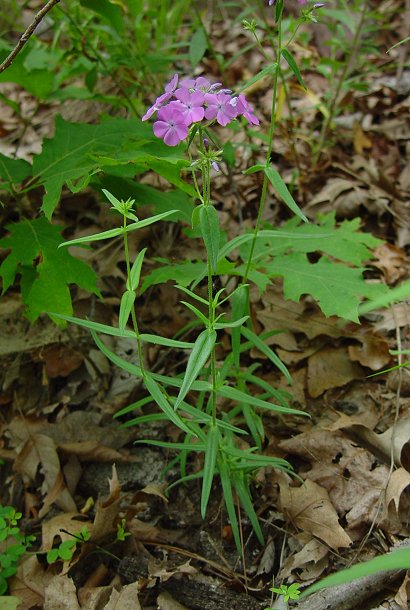Phlox pilosa L.
Prairie Phlox

Native
CC = 6
CW = 3
MOC = 75
© DETenaglia
Phlox pilosa L.Prairie Phlox | |
 |
Native CC = 6 CW = 3 MOC = 75 |
© DETenaglia |
|
Family - Polemoniaceae Habit - Perennial forb with taproot and slender rhizomes. Stems - Flowering stems ascending to erect, to 60 cm tall, typically 1-3, with 6-17 nodes, usually simple below but branching at inflorescence, moderately to densely pubescent with multicellular, spreading to curved or crinkled hairs, some or all of these sometimes gland-tipped. Vegetative stems not produced or, if present, then shorter than but otherwise similar to the flowering ones.
Leaves - Opposite, the uppermost occasionally subopposite, sessile, simple, the the blades linear to lanceolate or ovate toward the tip, angled or tapered to a sharply pointed tip, angled or tapered at the base, the largest 3.5-8.0 cm long and 2-20 mm wide, with single prominent midrib, the margins usually short-hairy, the surfaces sparsely to densely hairy, the hairs nonglandular or gland-tipped, the secondary veins obscure, pinnate and not forming conspicuous loops.
Inflorescences - Terminal and axillary domed panicles, typically with 15-60 flowers. Peduncles and pedicels densely glandular-pubescent. Pedicels to 9 mm long. Flowers often subtended by linear-lanceolate bracts.
Flowers - Calyces 7-14 mm long, the lobes slender, long-tapered to sharply pointed tips, often with some purplish coloring, glandular- or nonglandular-hairy. Corollas pink to light purple, rarely white, the tube 10-16 mm long, usually moderately to densely hairy externally, with a slight constriction 1.5-3.0 mm above the base, the 5 lobes 6-14 mm long and 4-11 mm wide, obovate or less commonly oblanceolate, rounded at the tips, sometimes with an abrupt, short point at the very tip. Stamens with the filaments 4-15 mm long, the anthers positioned above the stigma within the tube, not exserted. Style 0.4-1.0 mm long, the stigmas 0.9-1.6 mm long. Ovary glabrous, green, 1.1 mm long, superior, 2-3-locular.
Flowering - April - June, sometimes again in the late fall. Habitat - Glades, savannas, prairies, forests, bluffs, pond margins, streambanks, fens, pastures, fields, railroads, roadsides. Origin - Native to the U.S. Lookalikes - Other species of Phlox, especially P. divaricata. Other info. - This attractive species is fairly common throughout most of Missouri. Its main U.S. distribution is within a wide band running north to south within the Midwest, though more scattered populations are also found out to the Atlantic Coast. It also ranges into Canada and Mexico. The shape of the flowers readily identifies the plant as a phlox, but it can sometimes be confused with other species in the genus. Characters to look for include hairy stems and leaf margins, and lower leaves which are typically narrow. The anthers are usually positioned close enough to the throat of the corolla tube to be visible without dissecting the flower. The long corolla tube is pubescent externally, which easily distinguishes this plant from its closest lookalike, P. divaricata. Photographs taken on Taum Sauk Mountain, MO., 5-23-03 and 5-31-03 (DETenaglia); also at Danville Conservation Area, Montgomery County, MO, 4-28-2016 (SRTurner). |